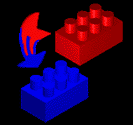 |
 |
 |
 |
| Methods | Storyline | Reviews | Discography |
| New material at myspace.com/rudyschwartzproject! Music available at DC-Jam Records |
|||

 |
 |
 |
 |
| Methods | Storyline | Reviews | Discography |
| New material at myspace.com/rudyschwartzproject! Music available at DC-Jam Records |
|||
![]()
Most of what I do is performed by a computer. Usually, I'd much rather have it played by humans, but economics, my patience for the human species, and sometimes complexity preclude this. A group of great musicians will, in most cases, sound better than a machine. But, a machine will always sound better than a group of people who are drunk, stoned, and don't give a fuck. It's also easier to get a wide timbral palette from samplers than from a rock band, and computer music can also be enhanced by adding "live" elements, without enduring the pain of working with an entire band. Life is full of these little compromises. Anything of consequence rarely turns out perfectly. A stitch in time will save nine, etc.
Another advantage of writing music on a computer is that ideas can be tested quickly, then accepted or discarded, without the inconvenience of rehearsal, and without the irritation of convincing someone that they should devote their time to it. Computers can also play things that humans can't touch. And vice versa.
So anyway, most of my music is played by a computer, with some extra tracks usually included with the hope that the listener can be distracted from noticing the mechanical feel of the MIDI sequences. In the vast majority of cases, the MIDI sequence is painstakingly assembled (some of them have taken over two months to build), then mixed through the on-board 20-track mixer of the Tascam 688 that I've used on the last three projects. The Tascam 688 is an amazing machine, by the way, and I've never been disappointed with any Tascam product. But I digress.
The 688 has four effects loops, and in-line effects for each channel. Usually, I'll have two or three reverbs, and maybe some gimmicky in-line effect for a MIDI mix-down, and all of the MIDI audio will be recorded to two tracks, leaving six tracks for vocals, guitars, or whatever. On rare occasions, I'll ping-pong backing vocals among the six tracks, but I like to keep that sort of shit down to a minimum. Horn sections are almost always recorded with a large reverb. Snare drums with gated reverb, blah blah blah. The usual crap. The 688 also has a sweepable pseudo-parametric EQ on ten of its inputs, which makes an amazing difference in dense mixes. I usually use this sparingly on just about every channel, to help place each voice into a unique part of the frequency spectrum.
Typically, there will be a lead vocal recorded in stereo. I like to run a dry signal to one side of the mix, and use a wee bit of digital delay on the other side. This fattens up the lead vocal considerably, and makes anyone's voice sound more impressive. Compression and sometimes chorusing are also used on lead vocal tracks. The last couple of albums were recorded with an Ensoniq DP-4, which is a great box for anyone on a budget. Don't expect it to be as clean as a Lexicon, though.
Backing vocals are usually recorded in mono, with whatever effect is appropriate for whatever cliche I'm trying to mock. Electric guitars are usually miked from the amp with a Shure SM57. I run acoustic guitars straight into the board with a pickup. Vocals are miked with an SM58. Cheesy, but cheap.
Sometimes I deviate from the formula described above. For example, the last track on the Salmon Dave CD is called "A Nice Selection of Hasps." This is a collaboration between Brooks Coleman and myself. One day in 1987, I took my four-track over to Brooks' house and spent the afternoon taping him making noises on his amazing array of junkyard percussion instruments. Then, about six years later, I dug out the tapes, and assembled them into a collage, using cheap tricks like changing tape speeds. I also overdubbed some new tracks to make the dead spaces more interesting.